Indexing & Abstracting
Full Text
Research ArticleDOI Number : 10.36811/jvsr.2021.110012Article Views : 2Article Downloads : 1
Mercury (Hg) researches in Brazilian biomes: A scientometric analysis between the years 1991 and 2018
Miguel V. M. Neto* and Darlan Q. Brito
University of Brasília, Faculty UnB at Planaltina (FUP/UnB), Planaltina, Federal District (DF), Brazil
*Corresponding Author: Miguel V. M. Neto1, University of Brasília, Faculty UnB at Planaltina (FUP/UnB) Planaltina, Federal District (DF), 73.345-010, Brazil, Email: miguelv17@gmail.com
Article Information
Aritcle Type: Research Article
Citation: Miguel V. M. Neto, Darlan Q. Brito. 2021. Mercury (Hg) researches in Brazilian biomes: A scientometric analysis between the years 1991 and 2018. J Veterina Sci Res. 3: 01-13.
Copyright: This is an open-access article distributed under the terms of the Creative Commons Attribution License, which permits unrestricted use, distribution, and reproduction in any medium, provided the original author and source are credited. Copyright © 2021; Miguel V. M. Neto
Publication history:
Received date: 15 December, 2020Accepted date: 31 December, 2020
Published date: 04 January, 2021
Abstract
Mercury is a metal present in natural sources and its concentration have been allocated by human activities, posing impacts in environmental matrices and organisms. In this study, we highlight the panorama of Hg researches in Brazilian biomes in the scientific literature published between 1991 and 2018. Although the appreciated attention to the mercury researches in Amazon context, there has not been an assessment of Hg research within other Brazilian biomes. With this in mind, we searched for articles in the periodic database the Thomson’s ISI Web of Science database and observed an oscillated trend of the number of publications throughout this period. The low percentage of papers performed in Pantanal (8%), Caatinga (4%), Atlantic Rainforest (4%), Pampa (3%) and Cerrado (0.36%) was contrasted to majority academic works performed in Amazon regions (83%), indicating the asymmetrical geographical distribution in Hg researches. The five top keywords of research topics were mercury, Amazon, Brazil, river, Brazilian and fish. The top authors formed 19 different clusters, with different research directions and strengths. Our data shows that Hg studies have been geographically biased. The lack of Hg studies on other Brazilian biomes may mask the extent and intensity of the impacts related to the Hg mobilization in these areas. Concerning Hg concentration is context-dependent, we emphasize the need for investment in Hg research in different tropical biomes in order to overcome spatial bias of Hg knowledge, particularly with organisms from different environmental matrices.
Keywords: Scientometry; Mercury; Brazilian biomes, Web of science (WoS)
Introduction
Mercury (Hg) is a metal present in natural sources; however, a considerable proportion of Hg have been allocated by burning of fossil fuels, mining, and other human actions [1,2]. Mercury is found in three valence states (0, +1 and +2), and in several inorganic and organic complexes [3]. The physical-chemical properties and interactions of these species with environmental matrices determine the mechanisms of transport, transformation and removal of mercury [4]. The proportion of Hg species varies in different environmental compartments [5] and may affect its bioavailability and toxicity [6]. The [Hg] in the atmosphere is appreciable due to its volatility be directly proportional to the temperature increase [7] and more than 95% of it is found in Hg0 steam [8,9]. The largest [Hg] present in the abiotic part is in the inorganic form of Hg (II), while methylmercury (MeHg) predominates in biota [10]. Mercury is biomagnified in most food chains [11] and its methylation increases the potential for biomagnification through the trophic food chain [12,13]. Environmental Hg loadings have had significant impacts on wildlife populations and increased overall human risk population-level health [14]. Mercury studies over the last decade are considerably due to the advances basically on three major fields: new data, new models and new techniques and analytical and dynamic tools [10,15-17]. Considering this, scientometric studies have been crucial to identify trends, gaps and biases in the scientific development, as well as guide future topic researches [18-20]. Although the welcome attention to the mercury researches in Amazon context [20] there has not been an assessment of Hg research within other Brazilian biomes. Brazil is the largest country in Latin America and houses a great variety of ecosystems ranging from grasslands and savannas to wetlands and dense tropical rainforests [21-23]. Considering this gap in knowledge, the great interest of Hg impacts on different environmental matrices across the country and the importance of evaluating the scientific production, we aimed to provide a panorama Hg researches in Brazilian biomes throughout the last three decades (1991 to 2018). We also aimed to answer the following questions: (i) what is the status of Hg researches in Brazilian biomes? (ii) The topic studies vary between biomes? and (iii) Are the major Hg fields related to land use intensity, economic activity or public health? Then, our study aims to contribute to a better understanding of Hg studies in Brazilian Biomes.
Materials and Methods
In order to evaluate the Hg research in Brazilian biomes, we employed a combination of bibliometric citation and content analysis techniques. We used the Thomson ISI Web of Science database (ISI WoS) to search for articles published from 1991 to 2018. The year 1991 was chosen as the initial by the fact that the abstracts were only available for articles published from 1991. First, we performed a Boolean search for articles in September of 2019 using a combination of the following terms: TI (Title) = (*mercur* OR Hg) and TS (Topic) = (Amazon*) for Amazon, (Brazil* semi arid* and Brazil* northeast*) for Caatinga, (Savanna*) for Cerrado, (Brazil* Atlantic forest*) for Atlantic Rain Forest, (Pantanal*) for Pantanal and (Paraná and Rio Grande do Sul) for Pampa in the ISI Web of Science database. The six terrestrial biomes identified in this study (Amazon, Caatinga, Cerrado, Atlantic Rainforest, Pampa and Pantanal) followed the 2004 habitat classification from the Brazilian Institute of Geography and Statistics (IBGE–acronym in Portuguese). The selected articles were included in the compilation only when it was explicitly indicated that the study was fully or partially performed within Brazilian biomes. The results were then filtered by language (English) and document type (articles) in text files organized by biomes, which were then inserted individually into the free HistCite™ software (version 9.8.24 (Philadelphia, PA, USA) for bibliometric article analysis [24]. which provided the name of the first author, the journal names, the keywords/words of the title and the abstract of each article. We also used the VOS Viewer™ software, version 1.6.8 [25], which builds network connections of scientific publications, academic journals, researchers, countries, keywords (or terms based on co-authorship), citation, and bibliographic coupling. With this software, we could find published mercury-related research in the Brazilian biomes, the most significant authors in each area and how co-authorship networks have been established; and how publications and authors were grouped according to different research topics.
Results
Authorship and co-authorship analysis in all Biomes
After a refined analysis of abstracts, 281 academic works fitted the objectives of our study in international peer reviewed journals (Web of Science-WoS). The evaluation of selected articles showed an oscillating trend with a remarkable growth in the 2018 year (Figure 1a). About 83% of the academic works produced were related to Hg and Amazon Biome throughout this period. The 17% of the works were corresponded respectively to Pantanal (8%), Caatinga (4%), Atlantic Rainforest (4%), Pampa, (3%) and Cercado (0,36%) (Figure 1b). The number of citations of the publications reveals the leading authors and the key issues of interest in Hg research conducted in Brazil’s territory, as shown in table 1. It is important to note that the 6,825 references were analyzed from the 281 articles in the database and resulted in figure 2.
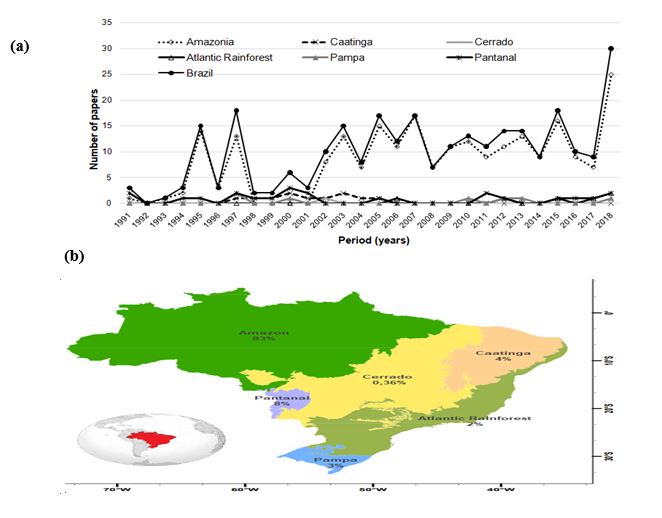
Figure 1 (a): Percentage of publications over the years studied (1991-2018) in each biome and (b) and the number of academic works dealing with mercury in each Brazilian biome throughout the study period (mapbiomas.org).
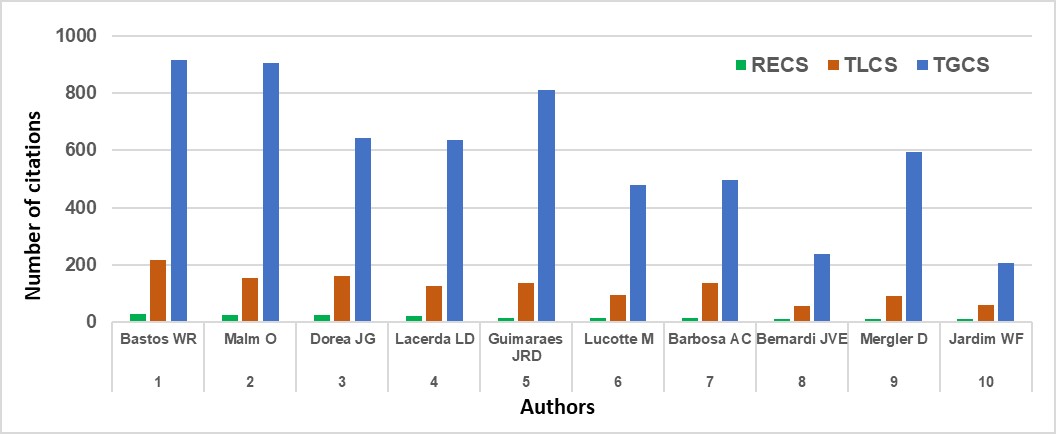
Figure 2: The ten most top authors cited in published articles about mercury and brazilian biomes between 1991 and 2018. RECS: Records; TLCS: Total Local Citation Score, and TGCS: Total Global Citation Score.
From 281 academic works analyzed, it was identified 18 authors that qualified as nodes of the collaboration networks. These nodes made up 19 main collaborative clusters as shown in figure 3.
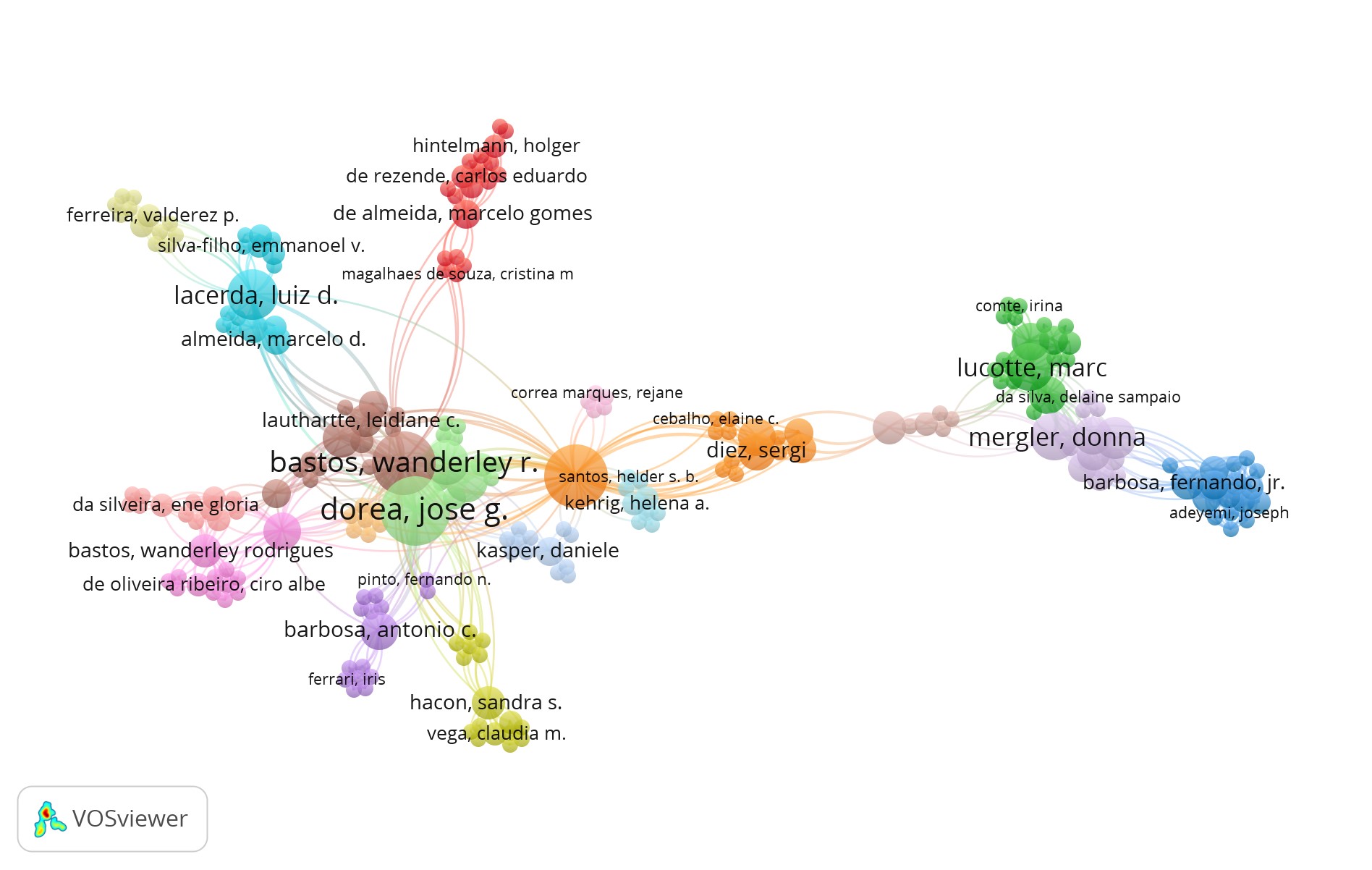
Figure 3: Authorship network regarding mercury research in the Brazilian Biomes.
Keywords Analysis
There were 952 words listed in the title and abstract from analyzed articles. Following the criteria that the word should appear in at least ten publications and removing synonymous words and terms unrelated to the research topic [20,26], we had 39 words with 708 links grouped in three main topic clusters from all academic works studied (Figure 5). The ten most used keywords ranked by frequency for each biome are listed in table 1. Considered all selected academic works, the five top keywords were respectively: mercury (254), Amazon (141), Brazil (86), river (57), Brazilian (56) and fish (55). The six most used keywords from academic works conducted in Amazon biome were very similar to the overall biomes. In contrast, the most frequent keywords in other Brazilian biome showed differences (Table 1). The main keywords in the studies related to the Hg and Brazilian Biomes (Figure 5) revealed three clusters: the blue group (n=8) with common terms Hg concentration, species, muscle and Madeira basin. The red group (n=18) with population, fish consumption, exposure, child and blood terms commonly used and the green cluster (n=17) which most pronounced words were sediment, water, river, soil, environment and data. The terms that linked the different groups were risk and environment. The main keywords presented in the academic works related to the research of Hg in the Amazon showed three clusters: the blue one (n=9) with species, blood, liver, muscle, turtle, and Amazon basin, as common terms. The red group (n=18) presented child, mother, community, fish consumption, and protein, and the green cluster (n=10) included river, site, water, soil and sediment (Figure 6). The main keywords in the studies related to the search for Hg in the Caatinga (Figure 7) revealed four clusters, with different foci: the yellow cluster (n=12) with gold mining, dissolved organic matter, and other heavy metals and the most commonly used term was carbonate. The green one (n=15) showed volcanic activity and sediment and the blue cluster (n=7) aggregated the river and land use and occupation terms. The red cluster (n=10) included mercury concentration in oysters. The terms that linked the academic works in this cluster were Amazon, Brazil, contamination, pollution, atmospheric mercury and accumulation. The main key words in the academic works related to the research of Hg in the Cerrado (Figure 8) showed only one cluster with commonly used terms were those related to soil and mineral sorption. Concerning Hg in the Atlantic Forest, the main keywords showed five clusters (Figure 9): The red cluster (n=15) encompassed fluxes, biodiversity and bioindicators; the green one (n=14) with litterfall, forest ecosystem and isotopic composition, as commonly used terms. The blue one (n=11) included atmospheric deposition, canopy, methylmercury and accumulation and the yellow one (n=7) aggregated photosynthesis and microclimate parameters while the purple one (n= 7) included land use change and ecosystem. With Pampa, the main keywords in the studies related to Hg research (Figure 10) showed two clusters: the green cluster (n=23) included water composition and maximum depth and the red one (n=30) included basically fish species. With Pantanal, the main keywords in the studies related to the Hg research (Figure 11) showed four clusters: the blue one (n=7) had methylmercury, methylation, soil, lake and root. The green one (n=9) aggregated fish, fish consumption, risk and mercury concentration. The red one (n=11) covered mining and mercury concentration terms and the yellow one (n=4) included mercury geochemistry, watershed pollution and reservoir contamination, as well as their association with atmospheric concentration. The term that linked the academic works in this cluster was sediment.

Figure 4: Co-authorship network regarding Hg research in the Brazilian Biomes between 1991 and 2018.
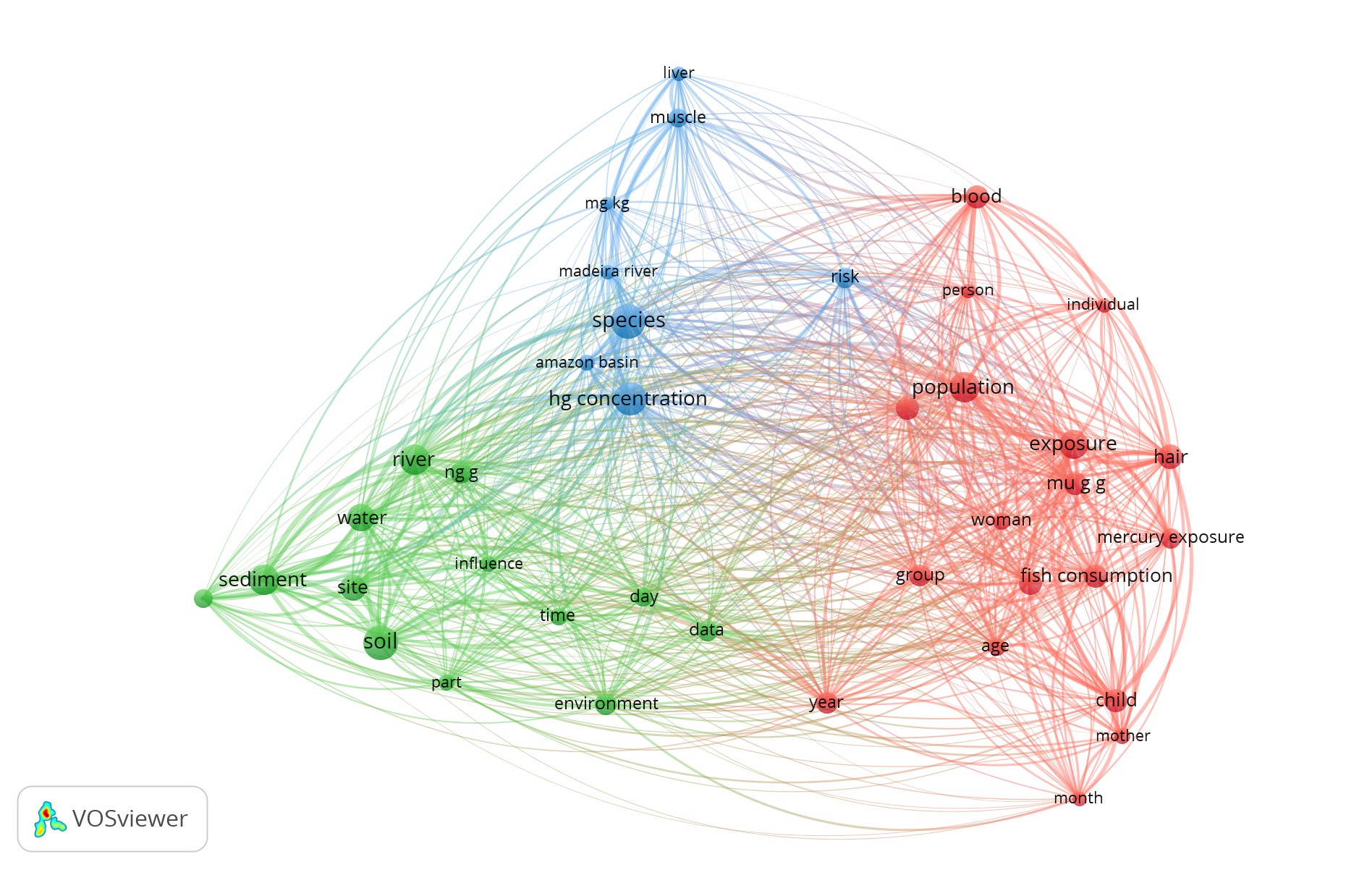
Figure 5: Networks of associations among the most used words in the publications about Mercury in Brazilian Biomes the between 1991 and 2018. The colors represent the clustering between them.
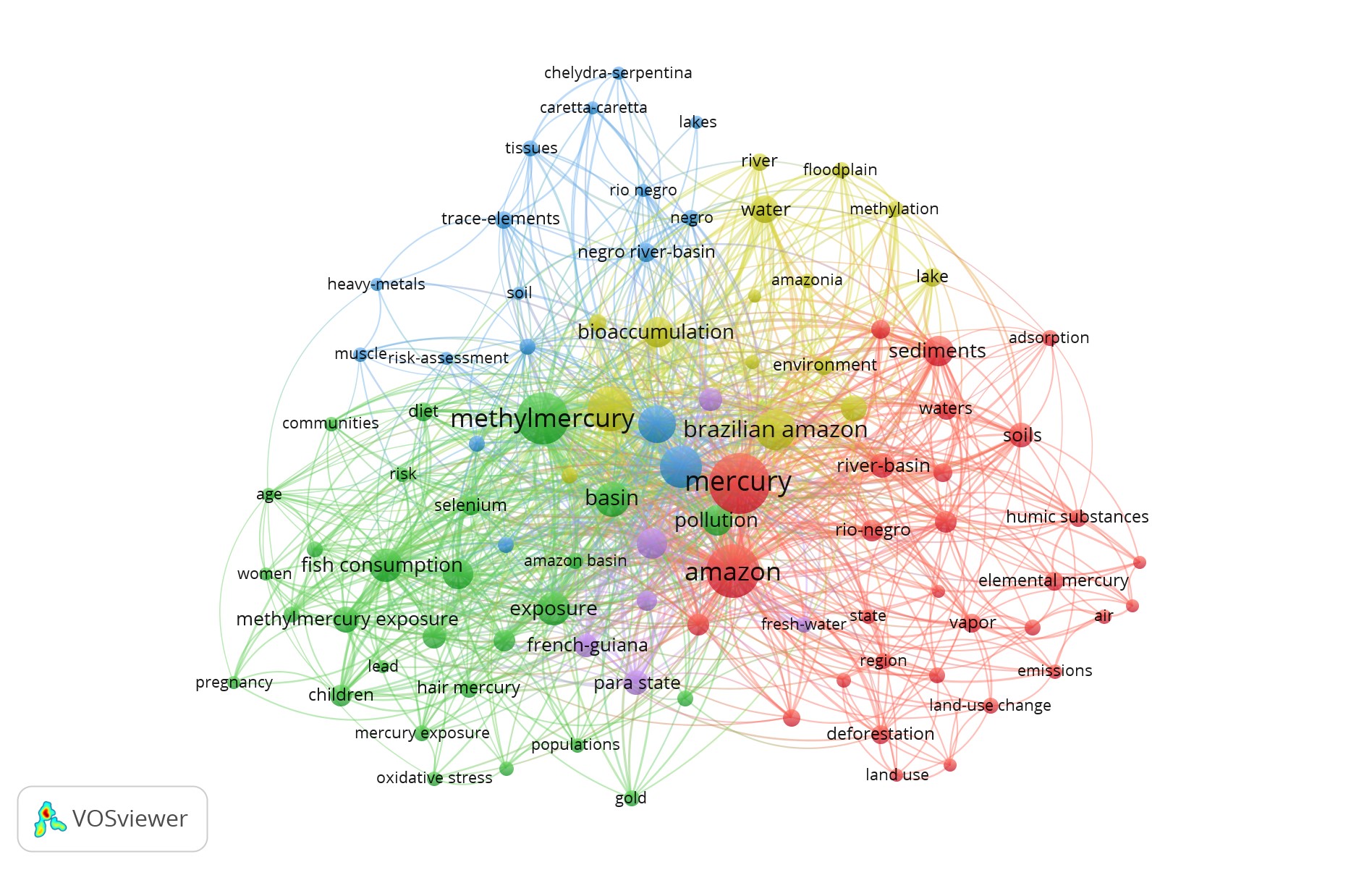
Figure 6: Networks of associations among the most used words of publications on Mercury in Amazon.
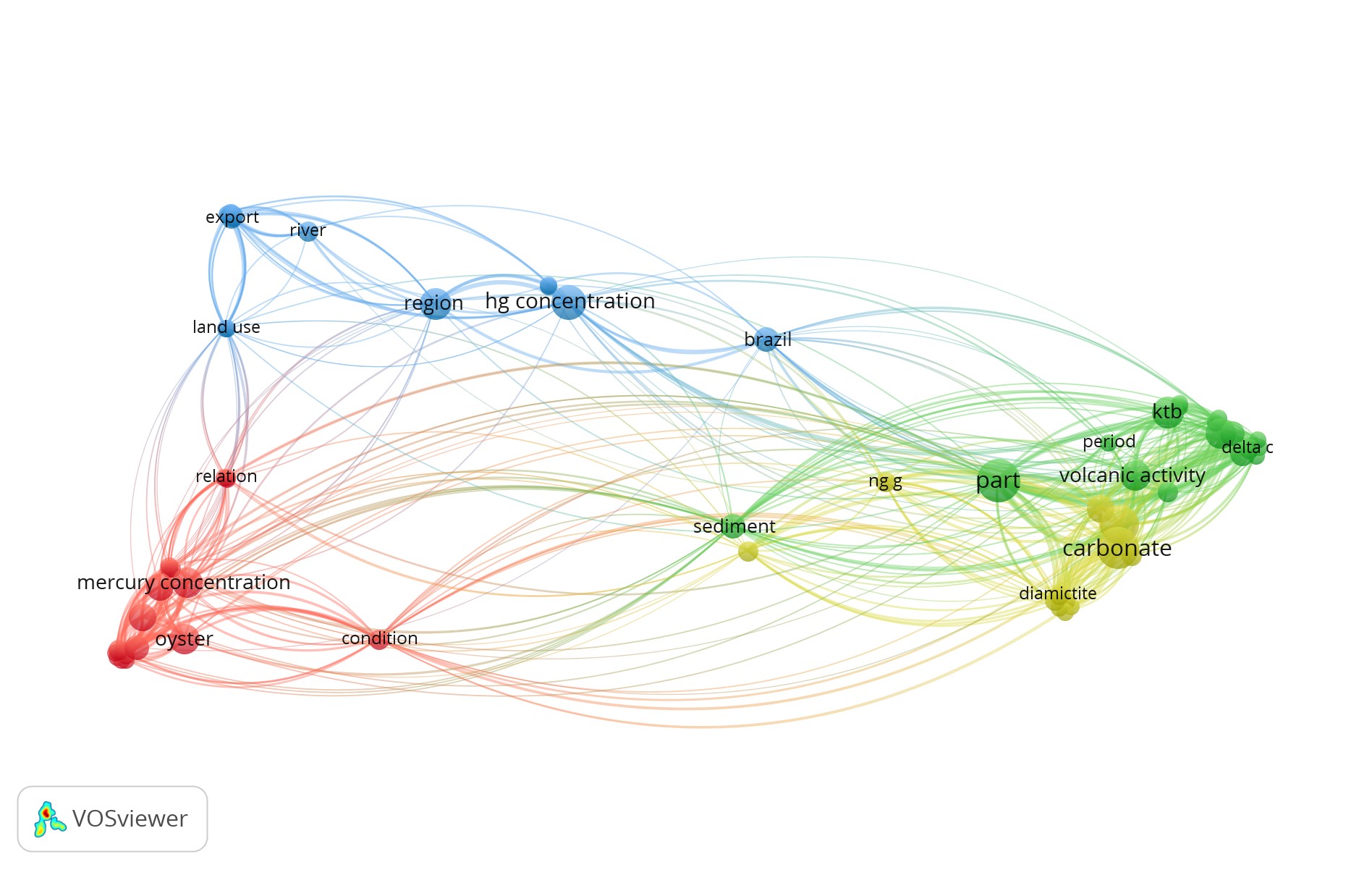
Figure 7: Networks of associations among the most used words of publications on Mercury in Caatinga.
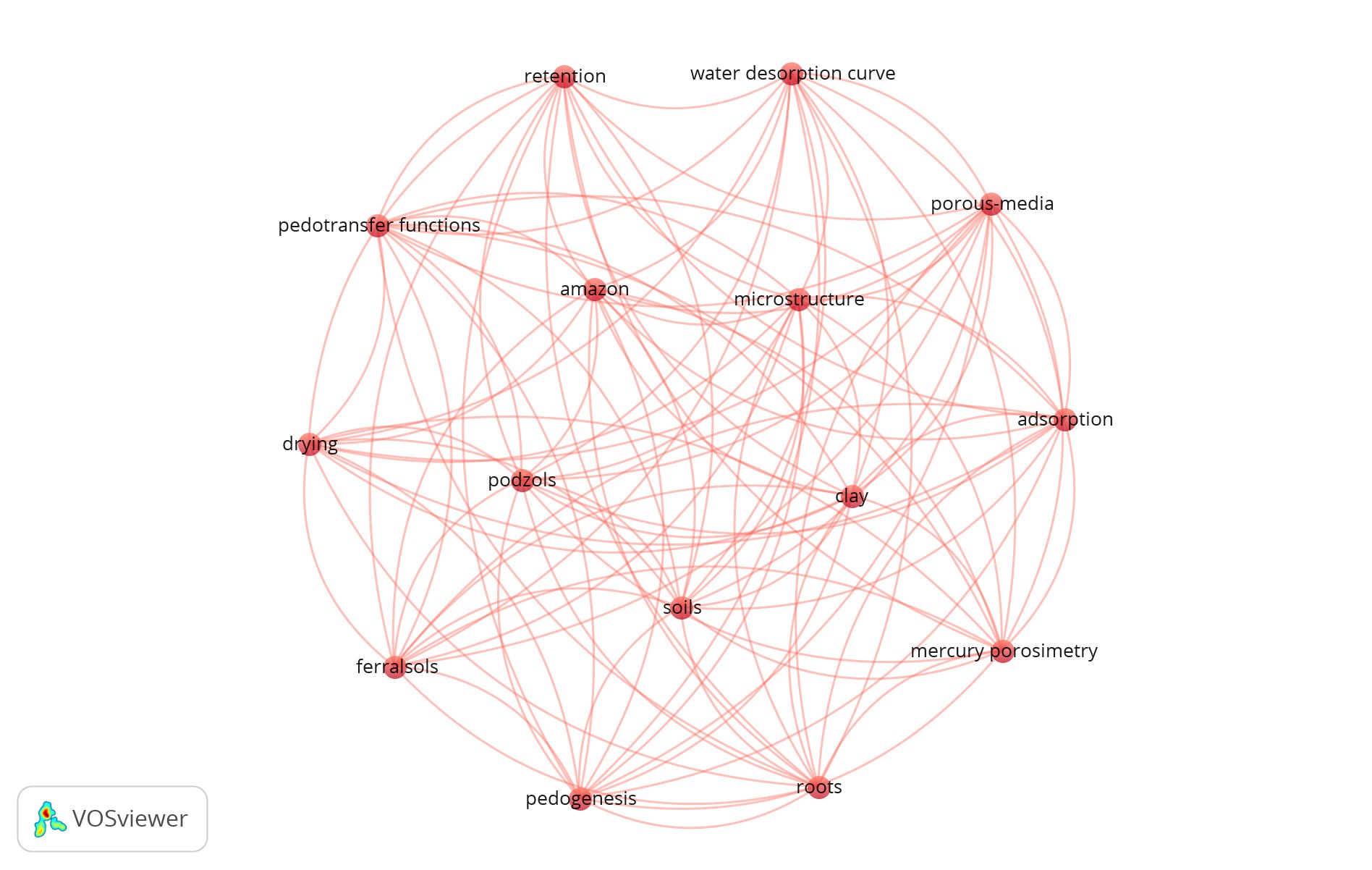
Figure 8: Networks of associations among the most used words of publications on Mercury in Cerrado biome.
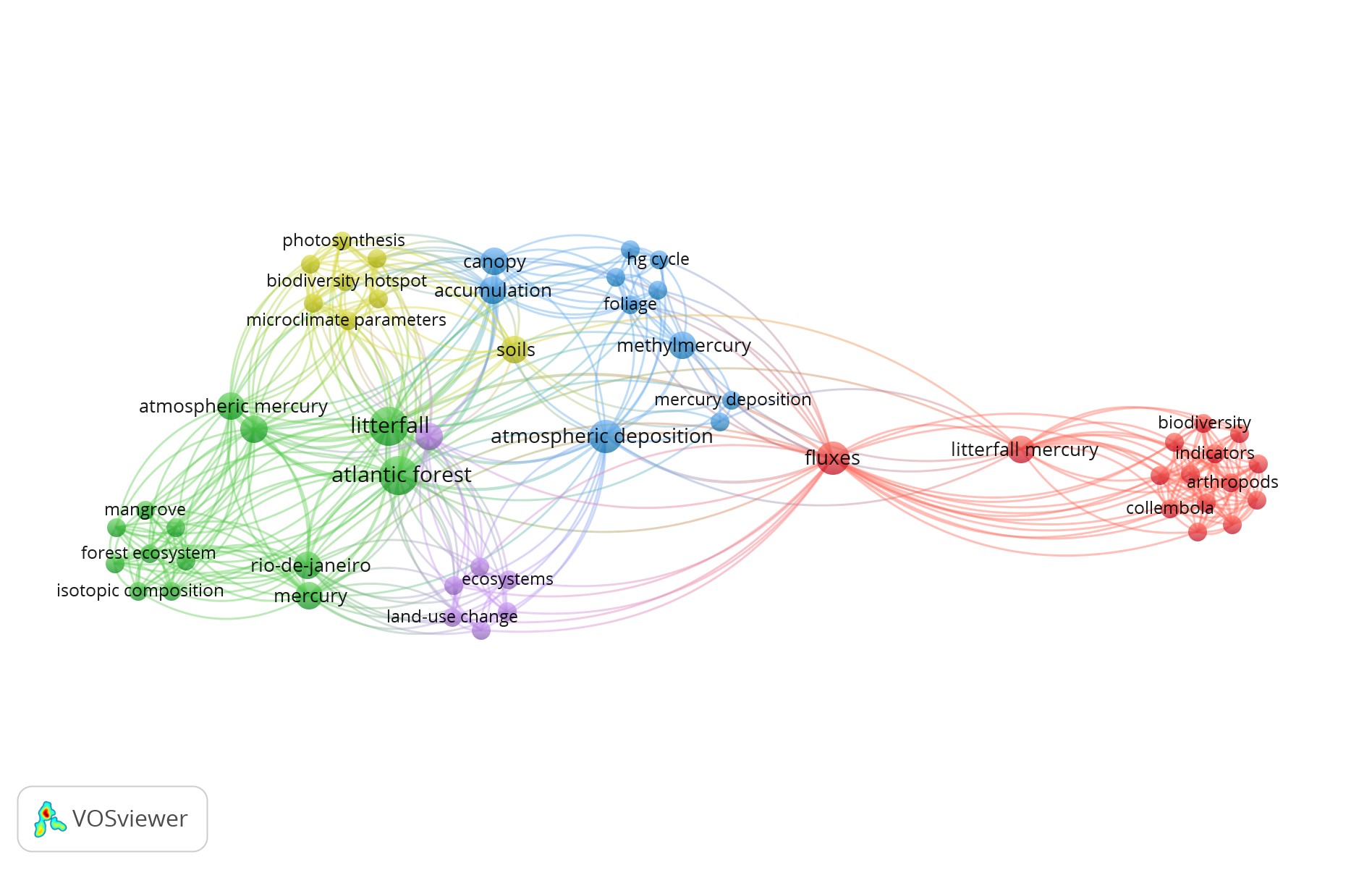
Figure 9: Networks of associations among the most used words of publications on Mercury in Atlantic Rainforest.
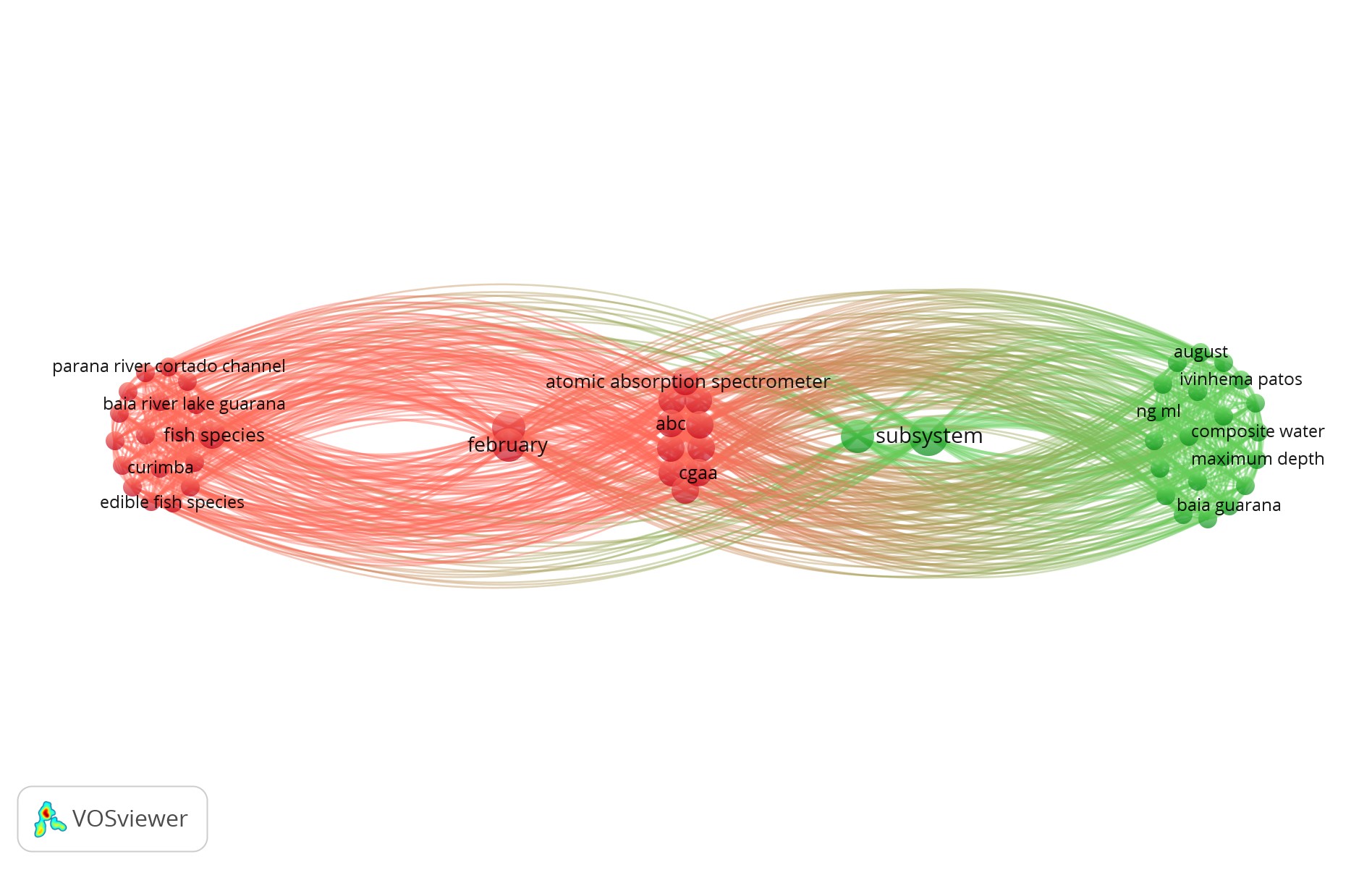
Figure 10: Networks of associations among the most used words of publications on Mercury in Pampa the between 1991 and 2018. The colors represent the clustering between them.
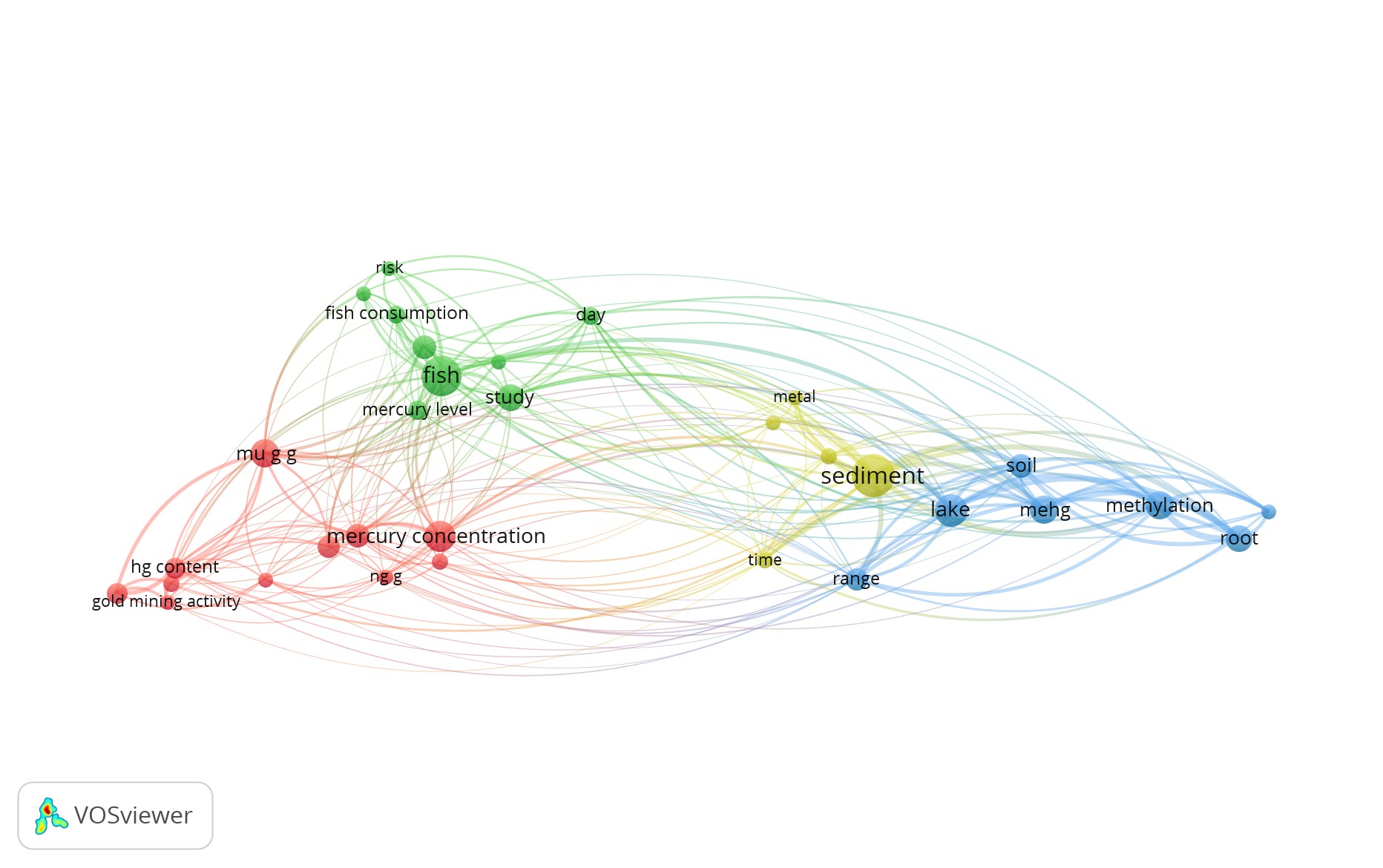
Figure 11: Networks of associations among the most used words of publications on Mercury in Pantanal the between 1991 and 2018. The colors represent the clustering between them.
Table 1: The ten most top academic works cited in published articles about mercury in Brazilian biomes between 1991 and 2018.
|
# |
Authors (Year) |
Citation |
Journal |
Impact Factor (JCR) |
|
1 |
Fadini, P.S.; Jardim, W.F (2001) |
55 |
Science of the Total Environment |
5.589 |
|
2 |
Roulet M., Lucotte M., Saint-Aubin A., et al. (1998) |
44 |
Science of the Total Environment |
5.589 |
|
3 |
Roulet, M., Lucotte, M., Farella, N. et al. (1999) |
41 |
Water, Air, & Soil Pollution |
1.774 |
|
4 |
Malm, O. (1998) |
37 |
Environmental Research |
5.026 |
|
5 |
Barbosa, A., Souza, J., Dórea, J. et al. (2003) |
35 |
Archives of Environmental Contamination and Toxicology |
2.135 |
|
6 |
Lechler, P. J.; Miller, J. R.; Lacerda, L. D.; Vilson, et al.; (2000) |
35 |
Science of the Total Environment |
5.589 |
|
7 |
Lebel, J., Roulet, M., Mergler, D. et al. (1997) |
34 |
Water Air and Soil Pollution |
1.774 |
|
8 |
Malm, O.; Pfeiffer, W. C.; Souza, C. M. M.;Reuther, R. (1990) |
34 |
AMBIO |
4.103 |
|
9 |
H. Akagi, O. Malm, Y. Kinjo, et al. (1995) |
31 |
Science of the Total Environment |
5.589 |
|
10 |
Pfeiffer, W. C.; Drude de Lacerda, L. (1988) |
31 |
Environmental Technology Letters |
NA |
Source: Research data. Citation column represents the number of citations received within the 281 articles considered in the analysis, at the moment of the data gathering. JCR: Journal Citation Report (2018) was accessed via the Web of Science database. NA: Not available.
Conclusions
Hg researches in tropical environments are crucial for a better understanding of its ecological processes in local, regional and ecosystem scale. In this sense, this comprehensive scient metric evaluation of mercury research in Brazilian biomes from 1991 to 2018 resulted in the following findings.
Findings
- Annual publications concerning mercury in the Brazilian biomes presented an oscillated trend over the years and the low number of academic works performed in Pantanal, Caatinga, Atlantic Rainforest, Pampa and Cerrado indicate the need for strategic studies in these biomes through national policies of research promotion.
- Authors formed 19 different clusters, with different research directions and strengths. We also identified the top influential scholars in the context of this study, such as Bastos, W.R. and Dórea, J.G.
-The five top keywords of research topics during the period considered were respectively mercury, Amazon, Brazil, river, Brazilian and fish.
Integrating scientific interest in Hg publications in the Brazilian biomes, our study identified strengths and weaknesses of Hg research areas, as well as a tool for future Hg research in Brazil´s territory.
Table 2: Main keywords ranked by frequency (F) in academic works dealing with Hg in each Biome and in all biomes (Brazil).
|
Amazon |
F |
Caatinga |
F |
Cerrado |
F |
Atlantic Rainforest |
F |
Pampa |
F |
Pantanal |
F |
Brazil |
F |
||||||
|
1 |
Mercury |
215 |
Mercury |
9 |
Amazonian |
1 |
Brazil |
5 |
Mercury |
7 |
Mercury |
21 |
Mercury |
254 |
|||||
|
2 |
Amazon |
140 |
Brazil |
6 |
Curves |
1 |
Mercury |
5 |
Brazil |
4 |
Pantanal |
14 |
Amazon |
141 |
|||||
|
3 |
Brazil |
61 |
Northeast |
4 |
Desorption |
1 |
Atlantic |
3 |
River |
4 |
Brazil |
11 |
Brazil |
86 |
|||||
|
4 |
River |
51 |
Northeastern |
4 |
Determination |
1 |
Deposition |
3 |
Basin |
2 |
Brazilian |
5 |
River |
57 |
|||||
|
5 |
Brazilian |
48 |
Brazilian |
4 |
Drying |
1 |
Forest |
3 |
Brazilian |
2 |
Fish |
5 |
Brazilian |
56 |
|||||
|
6 |
Fish |
48 |
Mangrove |
4 |
Effects |
1 |
Litterfall |
3 |
Floodplain |
2 |
Contamination |
4 |
Fish |
55 |
|||||
|
7 |
Exposure |
38 |
Estuary |
3 |
Ferrasols |
1 |
Tropical |
2 |
Paraná |
2 |
Gold |
4 |
Basin |
41 |
|||||
|
8 |
Basin |
37 |
Oyster |
3 |
Mercury |
1 |
Atmospheric |
1 |
Anthropogenic |
1 |
Levels |
4 |
Exposure |
38 |
|||||
|
9 |
Gold |
29 |
Rhizophorae |
3 |
Podzols |
1 |
Gold |
1 |
Areas |
1 |
Mato |
4 |
Gold |
33 |
|||||
|
10 |
Amazonian |
24 |
Accumulation |
2 |
Porosimetry |
1 |
Characterization |
1 |
Assessment |
1 |
Mining |
4 |
Mining |
26 |
|||||
References
1. Amos HM, Jacob DJ, Streets DG. 2013. Legacy impacts of all-time anthropogenic emissions on the global mercury cycle. Global Biogeochem. Cycles. 27: 410-421.
2. Schlüter K. 2000. Review: evaporation of mercury from soils. An integration and synthesis of current knowledge. Environ Geol. 39: 249-271.
3. Lindberg SE. 1986. Mercury vapor in the atmosphere: three case studies on emission, deposition, and plant uptake. In: Nriagu JO, Davidson CI (Ed.) Toxic Metals in the Atmosphere. 535-560.
4. Schroeder WH, Munthe J, Lindqvist O. 1989. Cycling of mercury between water, air, and soil compartments of the environment. Water Air Soil Pollut. 48: 337-347. Ref.: https://pubmed.ncbi.nlm.nih.gov/25530639/
5. Zhang H, Yin R, Feng X, et al. 2013. Atmospheric mercury inputs in montane soils increase with elevation: evidence from mercury isotope signatures. Ref.: https://pubmed.ncbi.nlm.nih.gov/24270081/
6. USDHHS. 1992. US DEPARTMENT OF HEALTH AND HUMAN SERVICES Toxicological Profile for Mercury: Update: Draft Report.
7. Adriano DC. 2001. Trace elements in terrestrial environments. New York: Springer-Verlag.
8. Baya AP, Van Heyst B. 2010. Assessing the trends and effects of environmental parameters on the behaviour of mercury in the lower atmosphere over cropped land over four seasons. Atmos Chem Phys. 10: 8617-8628.
9. Megaritis AG, Murphy B, Racherla PN, et al. 2014. Impact of climate change on mercury concentrations and deposition in the eastern United States. Sci. Tot. Environ. 487: 299-312. Ref.: https://pubmed.ncbi.nlm.nih.gov/24793327/
10. Beckers F, Rinklebe J. 2017. Cycling of mercury in the environment: Sources, fate, and human health implications: A review. Critical Reviews in Environmental Science and Technology.
11. UNEP. 2002. UNITED NATIONS ENVIRONMENT PROGRAMME Global Mercury Assessment. Chemicals, Geneva, Switzerland.
12. Porcela DB. 1994. Mercury in the environment: Biogeochemistry. In: Watras, C.J.; Huckabee, J.W. (Ed.) Mercury pollution: integration and synthesis Ann Harbor: Lewis Publishers. 1-19.
13. Horvat M. 1996. Mercury Analysis and Speciation in Environmental Samples. In: Baeyens, W., Ebinghaus, R., Vasiliev, O. (Ed.), Global and Regional Mercury Cycles: Sources, Fluxes and Mass Balances. Netherlands: Springer Netrherlands. 1-31.
14. Chen CY, Driscoll CT. 2018. Integrating mercury research and policy in a changing world. Ambio. 47: 111-115. Ref.: https://pubmed.ncbi.nlm.nih.gov/29388125/
15. UNEP. 2008. UNITED NATIONS ENVIRONMENT PROGRAMME. The global atmospheric mercury assessment: sources, emissions and transport. Chemicals, Geneva, Switzerland.
16. Ermolin MS, Fedotov PS, Malik NA, et al. 2018. Nanoparticles of Volcanic Ash as a Carrier for Toxic Elements on the Global Scale. Chemosphere. 200: 16-22. Ref.: https://pubmed.ncbi.nlm.nih.gov/29471164/
17. Obrist D, Kirk JL, Zhang L, et al. 2018. A review of global environmental mercury processes in response to human and natural perturbations: changes of emissions, climate, and land use. Ambio, 47: 116-114. Ref.: https://pubmed.ncbi.nlm.nih.gov/29388126/
18. Nabout JC, Carvalho P, Prado MU, et al. 2012. Trends and biases in global climate change literature. Natureza & Conservação. 10: 45-51.
19. Vaz UL, Cunha HF, Nabout JC. 2015. Trends and biases in global scientific literature about ecological niche models. Brazilian Journal of Biology. 75: 17-24. Ref.: https://pubmed.ncbi.nlm.nih.gov/26602335/
20. LCM, Dórea JG, Bernardi JVE, et al. 2019. Mapping the Evolution of Mercury (Hg) Research in the Amazon (1991–2017): A Scientometric Analysis. Int. J. Environ. Res. Public Health. 16: 1111. Ref.: https://pubmed.ncbi.nlm.nih.gov/30925692/
21. Eiten G. 1972. The cerrado vegetation of Brazil. The Botanical Review. 38: 139-148.
22. Lopes AS, Cox FR. 1977. Cerrado Vegetation in Brazil: An Edaphic Gradient. Agron. J. 69: 828-831.
23. Ribeiro JF, Walter BMT. 2008. As principais fitofissionomias do bioma Cerrado. In: Sano, S. M., Almeida, S. P., Ribeiro, J. P. (ed) Cerrado ecologia e flora. Brasília: Embrapa. (in Portuguese). 153-212
24. Garfield E. 2009. From the science of science to Scientometrics visualizing the history of 3. science with HistCite software. J. Informetr. 3: 173-179.
25. Van Eck NJ, Waltman L. 2010. Software survey: VOSviewer, a computer program for bibliometric mapping. Scientometrics. 84: 523-538. Ref.: https://pubmed.ncbi.nlm.nih.gov/20585380/
26. Li C, Zhong H, Zhang W. 2020. Scientometric Analysis of Recent Literature on Arsenic Bio1accumulation and Biotransformation in Marine Ecosystems. Bulletin of Environmental Contamination and Toxicology.
27. Culnan MJ, O’Reilly III CA, Chatman JA. 1990. Intellectual structure of research in organizational behavior, 1972-1984: A cocitation analysis. Journal of the American Society for Information Science. 41: 453-458.
28. Verbeek A, Debackere K, Luwel M, et al. 2002. Measuring the progress and evolution in science and technology - I: The multiple uses of bibliometric indicators. International Journal of Management Reviews.
29. Rossetto DE, Bernardes RC, Borini FM, et al. 2018. Structure and evolution of innovation research in the last 60 years: Review and future trends in the field of business through the citations and co-citation analysis. Scientometrics. 115: 1329-1363.
30. Tahmooresnejad L, Beaudry C. 2018. The importance of collaborative networks in Canadian scientific research. Ind. Innov. 25: 990-1029.
31. Fearnside PM. 2018. Challenges for sustainable development in Brazilian Amazonia. Sustainable Development. 26: 141-149.
32. Klink CA, Machado RB. 2005. Conservation of the Brazilian Cerrado. Conservation Biology.
33. Maciel LG. 2006. Cerrado: Patrimônio Nacional? Origens de um discurso de exclusão e a não-referência ao bioma no artigo 22, §4º, da Constituição Federal de 1988. Dissertation, University of Brasília.
34. McCain KW. 1990. Mapping authors in intellectual space: A technical overview. Journal of the American Society for Information Science. 41: 433-443.
35. De Nooy W, Mrvar A, Batagelj V. 2011. Exploratory social network analysis with Pajek (Structural Analysis in the Social Sciences Book 27). Cambridge, Cambridge University Press.
36. Üsdiken B, Pasadeos Y. 1995. Organizational analysis in North America and Europe: A comparison of co-citation networks. Organization Studies. 16: 503-526.
37. Cronin B. 1998. Metatheorizing citation. Scientometrics. 43: 45-55.
38. Rondón A, Pérez LE. 1999. Mercury bioacumulation in fifteen dams of Bolivar state (Venezuela), estimated with the indicator fish Hoplias malabaricus. In: Barbosa J, Melamed R, Villas Bôas R (eds) Mercury as a Global Pollutant-Fifth International Conference, May 23-27, Rio de Janeiro, Brazil. CETEM-Center for Mineral Technology. Rio de Janeiro, Brazil. 277 -592.
39. Kehrig HA, Seixas TG, Malm O, et al. 2013. Mercury and selenium biomagnification in a Brazilian coastal food web using nitrogen stable isotope analysis: A case study in an area under the influence of the Paraiba do Sul River plume. Marine Pollution Bulletin. 75: 283-290.
40. Smith LC. 1981. Citation analysis. Library Trends. 30: 83-106.
41. Li K, Rollins J, Yan E. 2018. Web of Science use in published research and review papers 1997–2017: A selective, dynamic, cross-domain, content-based analysis. Scientometrics. 115: 1-20. Ref.: https://pubmed.ncbi.nlm.nih.gov/29527070/
42. IBGE. 2015. INSTITUTO BRASILEIRO DE GEOGRAFIA E ESTATÍSTICA IBGE launches group of historical data on Brazilian vegetation.
43. ISI WOS. 2020. Thomson Scientific. (No Date). Web of Science.




















